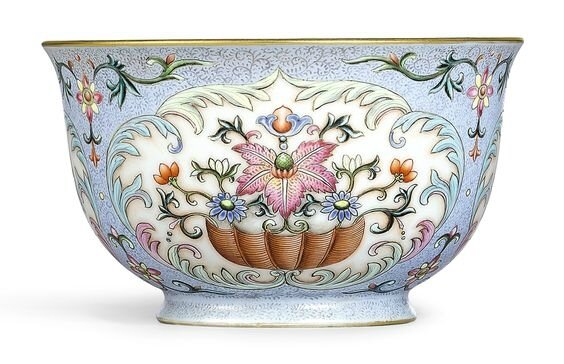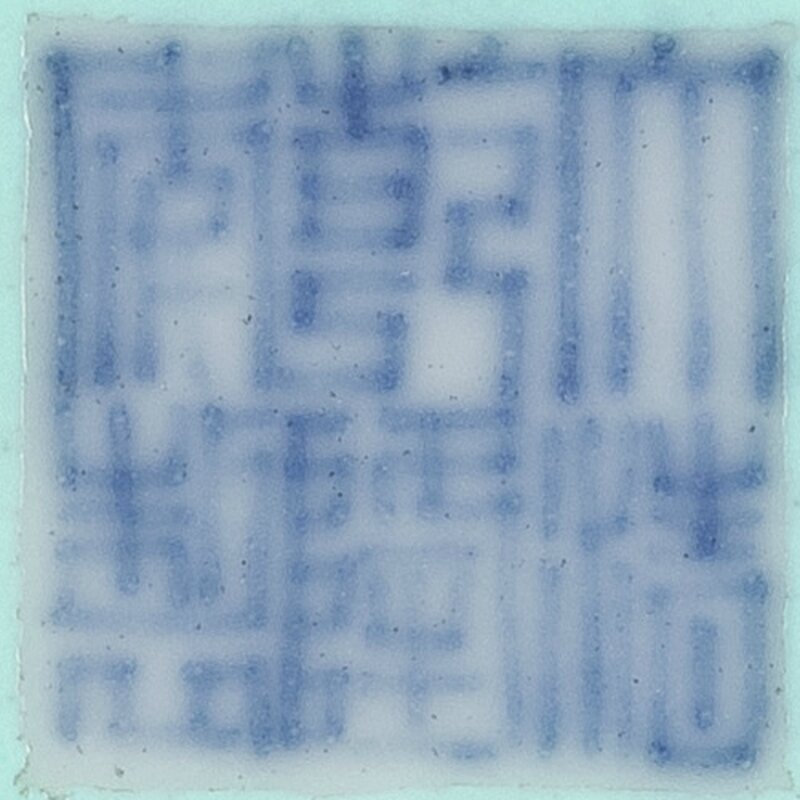An extremely rare and superbly enamelled blue 'yangcai' sgraffiato 'floral' bowl, Seal mark and period of Qianlong (1736-1795)
Lot 3107. An extremely rare and superbly enamelled blue 'yangcai' sgraffiato 'floral' bowl, Seal mark and period of Qianlong (1736-1795), 9.8 cm, 3 7/8 in. Estimate 7,000,000 — 9,000,000 HKD (900,830 — 1,158,210 USD). Lot sold 8,500,000 HKD(1,093,865 USD). © Sotheby's.
finely potted with deep rounded sides rising from a short splayed foot to an everted rim, the exterior meticulously decorated with three ruyi-shaped cartouches, each with a foliate border enclosing a basket picked out in sepia wash bearing luxuriant stylised floral blooms, the cartouches interrupted by undulating floral scrolls bearing leaves and tendrils, all against a pastel blue ground embellished in blue enamel with curling fronds in the sgraffiato technique, all between a gilt mouthrim and footring, the base enamelled turquoise save for a central white cartouche inscribed with an underglaze-blue six-character seal mark
Provenance: Collection of Caid Osman, France, and thence by descent.
Cabinet Portier & Associés, Paris, 29th November 2013, lot 106.
Note: Exquisitely enamelled and elegantly composed, this bowl belongs to a select group of yangcai porcelain produced for the Qianlong Emperor in the early years of his reign. Yangcai ware was greatly favoured by the Qianlong Emperor and was one of the most prized types of porcelain in the Qing court. These treasures were primarily kept in the Emperor’s largest private quarters, the Qianqinggong [‘Palace of Heavenly Purity’], located in the Inner Court of the Forbidden City, and in the European-style palaces of the Yuanmingyuan, another of his personal favoured settings. This bowl is particularly notable and rare for the effective use of a sepia wash to subtly outline the flower basket designs and leafy panels to give the impression of a warm golden glow and three-dimensionality.
No closely related counterpart to this cup appears to have been published; however it bears striking resemblance to related lavishly decorated yangcai wares recorded to have been produced between the sixth and tenth year of Qianlong and held in the National Palace Museum, Taipei, and shown in the Museum’s exhibition Stunning Decorative Porcelains from the Ch’ien-lung Reign, 2008. This exhibition effectively captured the spectacular new range of colours that were developed, thus endowing the wares with a Westernised flavour while remaining steeped in Chinese tradition. The present bowl may comprise one of the sixty-nine pieces of yangcai porcelain recorded as being presented to the Qianlong Emperor in the in the eighth month of the seventh year of his reign (corresponding to 1741). Elements of its design are seen on a number of pieces from this exhibition; for example see a pair of vases with similar flower baskets within leafy ruyi-shape cartouches, cat. no. 47 (fig. 1); and a bowl and vase with related leafy cartouches, cat. nos 3 and 38. Compare also a pair of powder-blue ground vases with incised sgraffiato fronds surrounding ruyi-shape panels depicting flowers, cat. no. 30. Most of the yangcai pieces with comparable decoration from the Qing court collection listed above can be dated to the seventh year.
Pair of gall-bladder vases in yangcai enamels with incised blue ground pattern of flower brocade and band decor, marks and period of Qianlong © Collection of National Palace Museum, Taipei
The palette and development of yangcai porcelain can be attributed to the genius of Tang Ying (1682-1756), Superintendent of the imperials kilns in Jingdezhen during the Yongzheng and early Qianlong periods. Liao Pao Show, in ‘On Yang-ts’ai Porcelains of the Ch’ien-lung Reign’, Stunning Decorative Porcelains from the Ch’ien-lung Reign, National Palace Museum, Taipei, 2008, p. 36, notes that the production of yangcai porcelain was perfected under Tang after the sixth year of the Qianlong Emperor, following the Emperor’s complaint that the porcelain made in the first six years of his reign were of significantly lower quality than those from the previous Yongzheng period.
These yangcai decorated pieces are characterised by their successful synthesis of traditional Chinese elements with newly acquired Western techniques. Thus they required the highest level of skill and execution and it is not surprising that they are exceedingly rare. As the term yangcai (‘Western colours’) suggests, the palette is inspired by European paintings, which relied heavily on the use of white pigment. The craftsman of the present piece has employed predominantly foreign hues of pastel blues, green and pinks and juxtaposed them with rich iron-red, a pigment developed from the early Ming dynasty. Western methods of creating the illusion of light and shadow through subtle tonal gradations fill the leafy scrolls that form the auspicious ruyi-shape cartouches, as well as the petals and lobed flower basket. A basket of flowers is the emblem of Lan Caihe, one of the Eight Daoist Immortals, and thus this motif carries the wish for wealth, good fortune and longevity.
Another influence on a number of yangcai porcelain was Beijing enamelled wares, first produced by Jesuit missionary artists working in the Qing court from the Kangxi reign. While known from metal-bodied wares, the use of pastel blue for the ground as seen on this bowl is unusual for porcelain. Furthermore, the employment of gold for the rim further suggests the influence of Beijing enamel on its aesthetics; for example see a painted enamel bowl, decorated with a peony scroll on a light blue ground, with Kangxi reign mark and of the period, in the Palace Museum, Beijing, illustrated in The Compendium of Collections in the Palace Museum. Enamels, vol. 5, Painted Enamels in the Qing Dynasty, Beijing, 2011, pl. 26.
The blue ground of this bowl has been further embellished with blue enamel curling fronds in the sgraffiato technique. Commonly known as jinshangtianhua (‘adding decorative pattern onto brocades’), the development of this laborious technique is also attributed to Tang Ying. The technique consisted of reserving the design on a monochrome enamel ground, which itself is structured by needle-point etching or enamelling of endless scrolling fronds. Such rich decoration, coupled with the generous spacing of the floral cartouches, is reminiscent of French rococo textiles, specimens of which would have entered the court through Jesuit missionaries and merchants in Guangdong.
Sotheby's. In His Majesty's Palm: Exquisite Porcelain Playthings, Hong Kong, 05 Apr 2017, 10:20 AM

/https%3A%2F%2Fprofilepics.canalblog.com%2Fprofilepics%2F1%2F0%2F100183.jpg)
/https%3A%2F%2Fstorage.canalblog.com%2F03%2F02%2F119589%2F96711876_o.jpg)
/https%3A%2F%2Fstorage.canalblog.com%2F11%2F31%2F119589%2F94773502_o.jpg)
/https%3A%2F%2Fstorage.canalblog.com%2F20%2F83%2F119589%2F94772815_o.jpg)
/https%3A%2F%2Fstorage.canalblog.com%2F26%2F72%2F119589%2F75604929_o.jpg)
/https%3A%2F%2Fstorage.canalblog.com%2F59%2F60%2F119589%2F26458628_o.jpg)






/http%3A%2F%2Fstorage.canalblog.com%2F30%2F70%2F119589%2F129487968_o.jpg)
/http%3A%2F%2Fstorage.canalblog.com%2F52%2F28%2F119589%2F129224434_o.jpg)
/http%3A%2F%2Fstorage.canalblog.com%2F17%2F07%2F119589%2F128937118_o.jpg)
/http%3A%2F%2Fstorage.canalblog.com%2F64%2F96%2F119589%2F128331827_o.jpg)